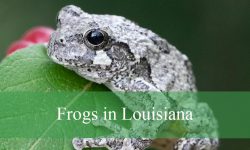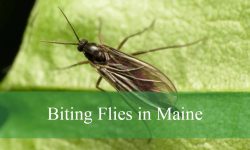Hawaii’s warm and humid climate creates the perfect environment for various centipede species to thrive. These multi-legged predators play important roles in the local ecosystem, but they can also surprise residents and visitors alike. Understanding their appearance and behavior helps keep encounters safe and informed.
Some centipedes in Hawaii are large and venomous, while others are smaller and harmless. Identifying these species can be tricky without guidance. This article breaks down five common types of centipedes you might encounter, complete with descriptions and identification tips.
Learning about these fascinating arthropods offers valuable insight into their ecological significance and behavior. Keep reading to discover how to spot and better understand the centipedes living in Hawaii.
Common Centipedes Found in Hawaii
Scolopendra subspinipes (Vietnamese Centipede)
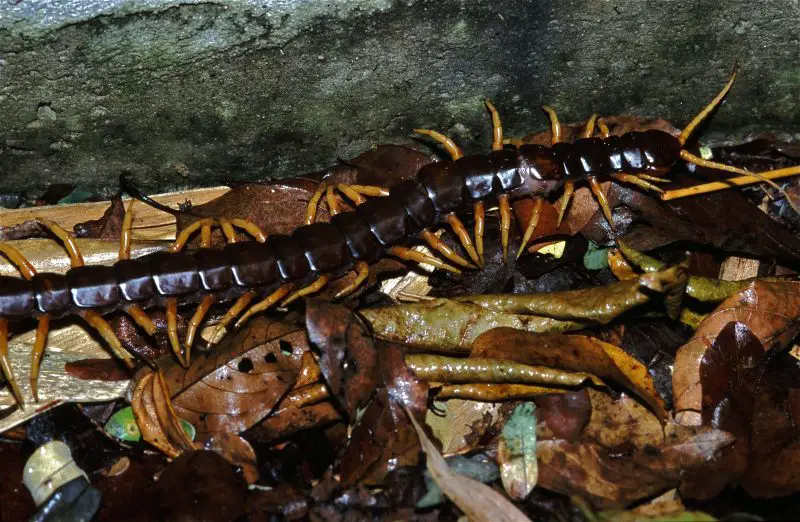
Scolopendra subspinipes is one of the largest and most formidable centipedes present in Hawaii. Adults can grow up to 8 inches (20 cm) in length, making them quite striking in appearance. Their bodies are flattened and segmented, with a deep reddish-brown coloration contrasted by yellowish legs and long antennae. This centipede’s robust build allows it to move swiftly and stealthily through its environment.
In Hawaii, S. subspinipes prefers warm, humid environments such as tropical forests, gardens, and places with abundant leaf litter or rotting wood. They are primarily nocturnal hunters, actively searching for prey at night. Their diet includes insects, spiders, small lizards, and occasionally small mammals. They use powerful venomous forcipules (modified legs) to inject venom that immobilizes prey quickly.
Behaviorally, this species is known for being aggressive when disturbed. It raises its front legs defensively and delivers a painful bite if threatened. While their venom is potent and can cause swelling and pain in humans, it is rarely dangerous unless the person has allergies or the bite becomes infected. S. subspinipes is solitary, spending most of its time hidden during the day.
Reproduction involves the female laying eggs in protected, moist locations such as soil or decaying logs. She guards the clutch diligently until the young hatch. The offspring resemble smaller versions of adults and grow through multiple molts before reaching full maturity. Due to its size and venom, this centipede is often feared but plays a key role as a top invertebrate predator in Hawaii’s ecosystems.
Lethobius sp. (Hawaiian Native Centipede)

Lethobius sp. is a smaller, native centipede species commonly found throughout the Hawaiian Islands. Adults usually measure between 1 and 2 inches (2.5 to 5 cm) in length. Their bodies are typically dull brown or tan, helping them blend seamlessly into the forest floor’s leaf litter and soil. Their slender and flattened shape enables them to easily navigate tight spaces.
This centipede favors moist, shaded environments such as forest floors, gardens, and compost piles. It is nocturnal, remaining hidden during the day under rocks, logs, or bark. Lethobius sp. preys on small arthropods including insects and spiders, using venomous forcipules to quickly subdue its prey. Compared to larger centipedes, its venom is milder and bites are rare.
The behavior of Lethobius sp. is relatively shy and non-aggressive toward humans. When disturbed, it tends to retreat rather than attack. It plays an important ecological role by naturally regulating insect populations, contributing to the balance of Hawaii’s native ecosystems.
Females lay eggs in moist, protected sites. They often guard the eggs until they hatch, showing some degree of parental care. Juveniles emerge looking like miniature adults and grow through a series of molts. Because it is native, Lethobius sp. is well-adapted to Hawaii’s unique environments and generally harmless to people.
Mecistocephalus maxillaris
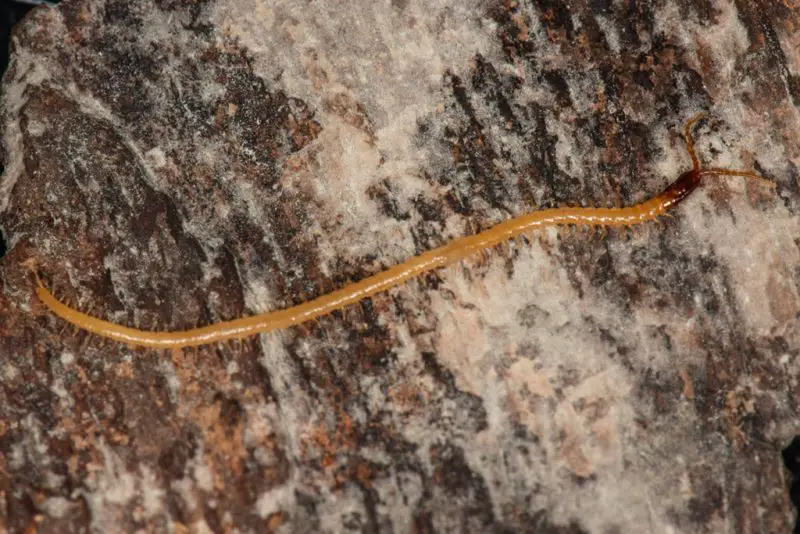
Mecistocephalus maxillaris is a slender and agile centipede species that inhabits forested and garden areas of Hawaii. Adults typically reach 2 to 3 inches (5 to 7.5 cm) in length. Their elongated, narrow bodies are usually pale yellow to light brown, providing excellent camouflage within leaf litter and soil.
This species prefers damp environments rich in decaying organic matter, such as mulch piles, forest floors, and beneath fallen logs. It is a nocturnal predator feeding primarily on small invertebrates like insects and spiders. Its speed and venom allow it to capture and immobilize prey effectively.
Mecistocephalus maxillaris is shy and avoids human contact, making bites very uncommon and usually not serious when they occur. Reproduction involves laying eggs in soil or protected areas, with juveniles hatching as smaller versions of adults. They grow by molting several times before maturity.
In Hawaii, this centipede helps control insect populations and contributes to nutrient cycling by living in areas with decaying organic matter. Its adaptability allows it to thrive in both native forests and urban gardens, supporting the ecological health of these environments.
Cryptops hortensis (Garden Centipede)
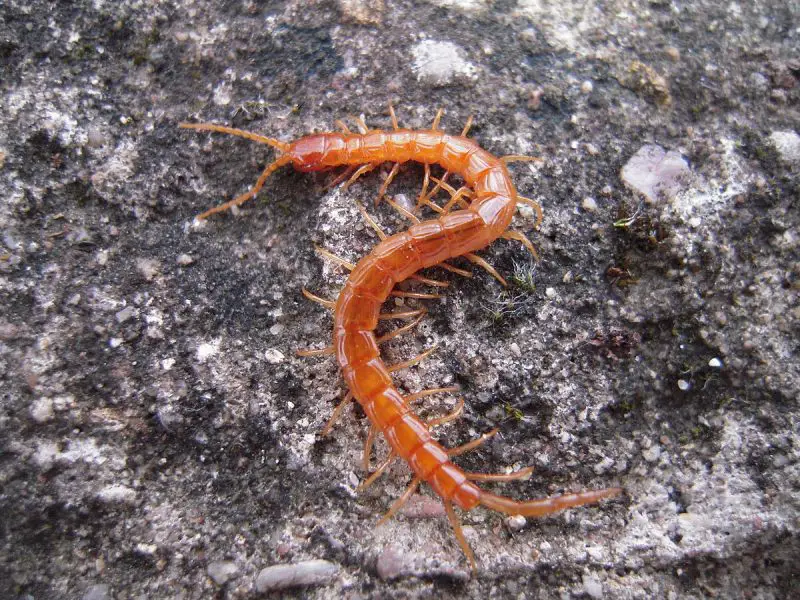
Cryptops hortensis, known commonly as the Garden Centipede, is a small species frequently encountered in moist garden soils throughout Hawaii. Adults range from 1 to 2 inches (2.5 to 5 cm) in length, with slender, brownish bodies that allow them to remain concealed beneath leaves, mulch, and soil.
This centipede prefers humid, shaded habitats such as gardens, forests, and compost heaps. It is nocturnal, hunting soft-bodied invertebrates such as earthworms, insect larvae, and other small arthropods. Using venomous forcipules, it efficiently subdues prey during nighttime activity.
Generally non-aggressive toward humans, Cryptops hortensis will retreat if disturbed. Although capable of biting, their venom is mild and bites cause only minor irritation. Females lay eggs in damp soil or sheltered areas, and juveniles develop through several molts until reaching full size.
In Hawaii, this species plays an important role in natural pest control by feeding on harmful garden insects and larvae. It also supports soil health by contributing to decomposition and nutrient recycling processes, making it a beneficial member of garden ecosystems.
Scutigera coleoptrata (House Centipede)
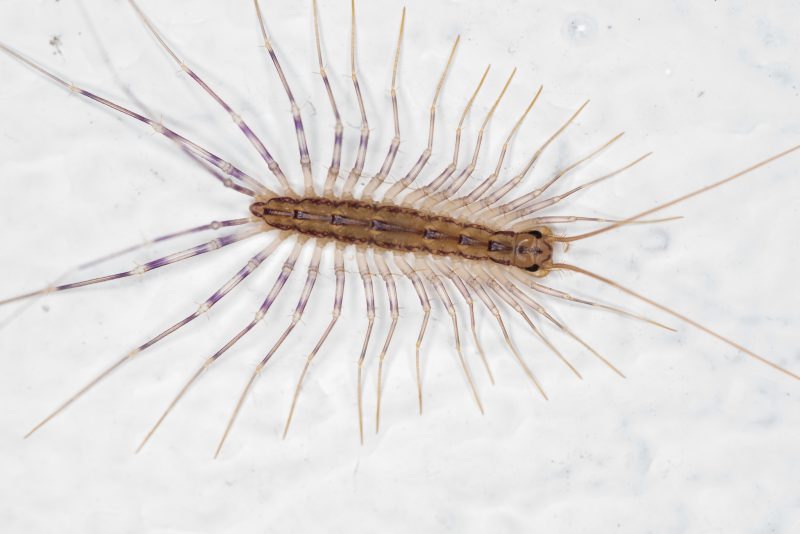
Scutigera coleoptrata, or the House Centipede, is easily recognized by its long, thin legs and rapid, spider-like movements. Adults grow to about 1.5 to 2 inches (4 to 5 cm) in length, with legs that extend significantly beyond their body, giving them a delicate appearance. Their bodies are pale yellow with distinctive dark stripes running lengthwise.
This species is commonly found indoors in Hawaii, especially in moist areas like basements, bathrooms, and kitchens. House centipedes prey on common household pests such as cockroaches, silverfish, spiders, and ants, making them valuable natural pest controllers.
House centipedes are shy creatures that avoid humans and rarely bite. When they do bite, their venom is generally harmless and causes only slight discomfort. They move quickly to capture prey and escape threats, with nocturnal activity patterns.
Reproduction involves females laying eggs in moist crevices inside homes. Juveniles resemble adults but are smaller, growing by molting their exoskeleton several times before reaching maturity. Because of their pest-control role, house centipedes are generally considered beneficial residents in Hawaiian households rather than pests.
FAQs About Centipedes in Hawaii
What types of centipedes are found in Hawaii?
Hawaii is home to several centipede species including the large and venomous Scolopendra subspinipes (Vietnamese Centipede), native smaller species like Lethobius sp., Mecistocephalus maxillaris, Cryptops hortensis (Garden Centipede), and the common indoor Scutigera coleoptrata (House Centipede).
Are centipedes dangerous to humans in Hawaii?
Most centipedes in Hawaii are not deadly to humans. However, the bite of large species like Scolopendra subspinipes can cause significant pain, swelling, and irritation. Smaller species generally have milder venom and bites rarely cause serious symptoms. It is best to avoid handling centipedes to prevent bites.
Where do centipedes live in Hawaii?
Centipedes in Hawaii inhabit a variety of environments. Large species prefer moist tropical forests, gardens, and areas with abundant leaf litter or rotting wood. Smaller native centipedes live in soil, compost, and forest floors. House centipedes are often found indoors in damp areas such as basements and bathrooms.
What do centipedes eat in Hawaii?
Centipedes are carnivorous predators that feed primarily on insects, spiders, and other small arthropods. Larger species may also prey on small lizards or rodents. House centipedes help control common household pests by feeding on cockroaches, silverfish, and ants.
How do centipedes reproduce in Hawaii?
Female centipedes lay eggs in moist, protected locations such as soil, leaf litter, or decaying wood. Some species, like Scolopendra subspinipes, show parental care by guarding their eggs until they hatch. Juveniles resemble miniature adults and grow through multiple molts to reach maturity.
How can I avoid centipede bites in Hawaii?
To minimize the risk of centipede bites, avoid handling or provoking centipedes. Reduce clutter, keep outdoor areas free of debris, and seal cracks in buildings to limit their indoor entry. Wearing gloves when gardening or moving wood can help protect against accidental bites.
Are centipedes beneficial in Hawaii?
Yes, centipedes play an important ecological role by controlling insect and arthropod populations. They contribute to natural pest management in gardens and homes and help maintain the balance of local ecosystems.

